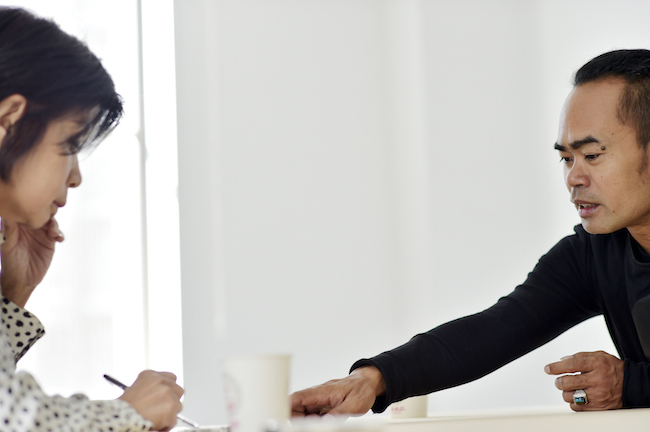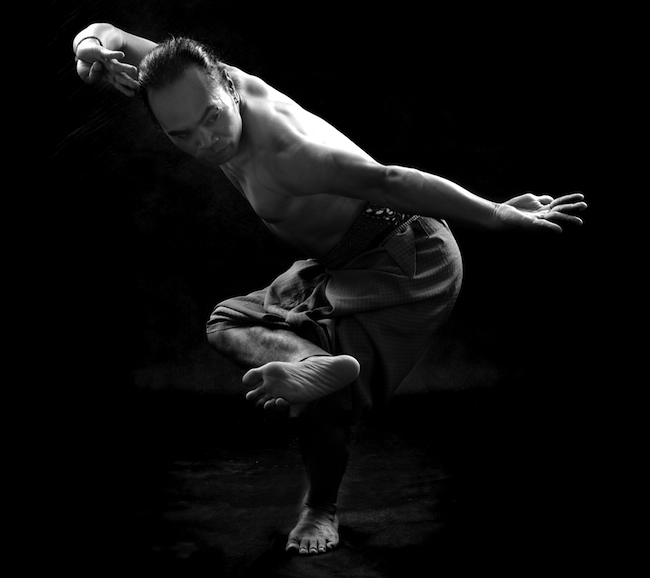Javanese Identity and the World
You were raised in Java, but were born in Kalimantan.
Eko: Yes. I was born in Banjarmasin, South Kalimantan. My father was a Dayak (proto-Malay indigenous people of Borneo) from East Kalimantan. He came to Java to enter high school, met my mother who was from Magelang (a city in Central Java), and fell in love with her. He went back to Kalimantan with her, but his family didn't let him marry a Javanese, so they moved to Magelang when I was five years old. My father married into my mother's family, and loved his father-in-law as if he were the real father. He didn't identify himself as a Dayak.
And you were raised in Magelang and began to study dancing. I think your dance is quite Javanese, and from the early stage you studied under the masters of Javanese traditional dance, Bagong Kussudiardja and Suprapto Suryodarmo, who are known as the initiators of the innovative movement that reinvestigated traditional dance from a new point of view. Why were you interested in the new direction while you were still young?
Eko: My mother's father had the traditional idea that a boy has to learn pencak silat (traditional martial arts), so my uncle trained me in pencak silat since when I was around five years old. Also, Magelang is known for various ethnic dances, which my grandfather taught me for five or six years. I was in the ethnic dance community in Magelang.
When entered high school, I was introduced to Bagong, who was in Yogyakarta, and I went back and forth between Magelang and Yogyakarta. I was lucky to be in that environment already before entering STSI. Soon after entering STSI (currently ISI) in Solo, I saw a performance by Suprapto. It was almost a fateful encounter. I wanted to understand what happened, so I approached him and pleaded with him to let me study with him. I would go everywhere he went and tried to learn from him.

And then you met Sardono Kusumo*4 . The innovator of Indonesian contemporary dance has been creating works through research and cooperation with local people since the 1970s. Your relation with Jailolo reminds me of his works.
*4 A dancer and choreographer from Java. With Javanese traditional dance as his background, his perceptive insight into the contemporary reality drew attention, and he has internationally been acknowledged since the 1970s. One of his main focuses is ecology, and among his numerous important pieces through research and collaboration with local people are Dongeng Dari Dirah (The Sorceress of Dirah, premiered in 1974, and a film version was made in 1992, directed by the choreographer himself), which he created in the village of Teges in Bali, Meta Ekologi (Meta Ecology, premiered in 1974) and Hutan Plastik (Plastic Jungle, premiered in 1983) which accused the destruction of the tropical rain forests in East Kalimantan. Currently, teaching at IKJ (Institut Kesenian Jakarta / Jakarta Institute of the Arts) and ISI campuses, he has still been influential as one of the most important artists in Indonesian arts and culture.
Eko: Sardono is the teacher and choreographer that I respect and was inspired by the most. I met him in 1993. My generation didn't witness his works in Bali or East Kalimantan, but I have read about them in various sources, heard about them from him, and seen the film version of Dongeng Dari Dirah. In 1995, while still being a STSI student, I participated in the Vienna and Hong Kong tours of his Passage through the Gong as a dancer. Sardono saw Cry Jailolo in Jakarta, and said to me, "What you are doing is exactly what I did, but the difference is in that you are literally diving into other cultures. In Bali, I was just a Javanese that were researching on Bali." I didn't imitate Sardono when I started Cry Jailolo, but what he said made me realize how much my artistic ideas were influenced by him in the depth. I happen to be following the path that he had followed, and I am happy about that.
After STSI, you went to UCLA. I suppose you met various dancers from the world there. Did that influence your view, thought or choreography?
Eko: Absolutely. Before UCLA, I was invited to American Dance Festival in 1997, where I was exposed to dances other than Javanese dance. That was a wonderful experience that expanded my concept of not only dance but also art.
UCLA did that to me too. I am grateful for the encounters with Victoria Marks, Judy Mitoma, and many others. Peter Sellars, also, let me learn about another aspect of dance through his operatic work. I also learned even from Madonna. Her tour that I took part in as a dancer was very professional and organized, which taught me about the reality of the non- academic world of dance. I taught Indonesian dance there too, which made me realize that Indonesia is vast, I knew only about Java, and the world of dance is huge and complicated. At the same time, I appreciated the fact that I was from Java and felt thankful to my teachers in Java including my grandfather.

You have worked together with such artists as Peter Sellars, whom you mentioned, and Lemi Ponifasio. You saw the world, while having the strong tradition of Java in your background. How have the universalism and particularism - in your case, "the Javanese" - reached an agreement in these collaborations?
Eko: In the collaboration with Peter Sellars, although he was the director, he didn't look down on me as the choreographer. It was a smart collaboration where I didn't see hierarchy. In contrast, Lemi Ponifasio completely used me as a dancer, and I had to exploit my body as if I were in the army (laughs). However, we discussed a lot in both projects, and that absolutely enlightened me.
A good example of what made me aware of my Javanese background is the collaboration with Arco Renz that I mentioned before, solid.states. This is a piece about the stability and instability of Javanese culture, which I performed together with a female dancer Melanie Lane. Melanie's mother is Javanese, and father is Australian. She was raised in Australia, so she doesn't know much about Javanese culture. On the other hand, even though I was raised in Java, I go abroad frequently, so sometimes I am told that I am not a Javanese anymore. In the piece Arco, as the negotiator, asks Melanie and me who we are, and we rediscover ourselves through answering his questions. I sometimes fought with Arco. I would say, "No, I can't do that, nobody does that in Java," and he would argue, "But you danced for Madonna and worked as dance consultant for The Lion King in the U.S." I said, "Then why don't you go to Java?" And then he really went there and studied Javanese dance for three months under my teacher. He also visited Magelang, my hometown, and learned pencak silat from my uncle as I did and heard the stories of my family. He came back and said, "Eko, your uncle told me this and that," which reminded me of my past. This process lasted for a year. I think what was more important than trying to be on equal footing with each other was that there was someone who led me to discover another aspect of myself.
- Next Page
- Taking Advantage of Entertainment






